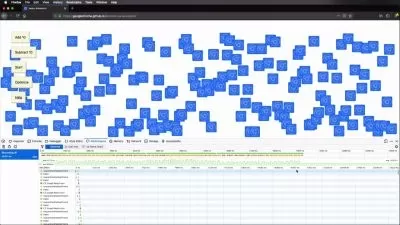JavaScript Interview Masterclass: Top 200 Questions & Answer
Happy Rawat
6:06:42
Description
Questions Covered - Basics/ Advance/ Coding/ Scenario Based JS Interview Questions(with PDF Book)
What You'll Learn?
- How to Crack JavaScript Interviews
- 200 JavaScript Interview Question and Answers
- 50 JavaScript Coding and Scenario Based Interview Questions
- JavaScript Interview Preparation
Who is this for?
What You Need to Know?
More details
DescriptionAre you checking out multiple websites and videos to collect the interview questions?
Â
Your search is over.
Â
This course contains the top 200 most important JavaScript questions.
Â
The instructor has more than 15 years of experience in full-stack development and has given and taken more than 100 interviews in his career.
Â
This course has 3 things with in it:
Â
1. The top 200 most important questions with their answers in the video lectures
Here are the topics covered:
Basics
Variables and data types
Operators & Conditions
Arrays
Loops
Functions
Strings
DOM
Error Handling
Objects
Events
Closures
Asynchronous programming: basics
Asynchronous Programming: Promises
Asynchronous Programming: Async Await
Browser APIs and Web Storage
Classes, constructors, this, and inheritance
ECMAScript and Modules
Security and Performance
Scenario-based: Tricky Short Questions
Scenario-based feature development questions
JS Coding Questions
All the questions are explained with the help of diagrams, code and definition. So that candidates can explain the answers in interviews with the help of examples.
2. 200 Interview Questions Book (pdf format and ppt) for Quick Revision.
The code is also present in the the ppt notes.
Â
3. Interview Preparation Excel: All questions listed in this tracker excel.
Just have a look just before the interviews.
All the best for your interview preparation.
Who this course is for:
- Candidate looking for JavaScript jobs in software industry
Are you checking out multiple websites and videos to collect the interview questions?
Â
Your search is over.
Â
This course contains the top 200 most important JavaScript questions.
Â
The instructor has more than 15 years of experience in full-stack development and has given and taken more than 100 interviews in his career.
Â
This course has 3 things with in it:
Â
1. The top 200 most important questions with their answers in the video lectures
Here are the topics covered:
Basics
Variables and data types
Operators & Conditions
Arrays
Loops
Functions
Strings
DOM
Error Handling
Objects
Events
Closures
Asynchronous programming: basics
Asynchronous Programming: Promises
Asynchronous Programming: Async Await
Browser APIs and Web Storage
Classes, constructors, this, and inheritance
ECMAScript and Modules
Security and Performance
Scenario-based: Tricky Short Questions
Scenario-based feature development questions
JS Coding Questions
All the questions are explained with the help of diagrams, code and definition. So that candidates can explain the answers in interviews with the help of examples.
2. 200 Interview Questions Book (pdf format and ppt) for Quick Revision.
The code is also present in the the ppt notes.
Â
3. Interview Preparation Excel: All questions listed in this tracker excel.
Just have a look just before the interviews.
All the best for your interview preparation.
Who this course is for:
- Candidate looking for JavaScript jobs in software industry
User Reviews
Rating
Happy Rawat
Instructor's Courses
Udemy
View courses Udemy- language english
- Training sessions 220
- duration 6:06:42
- Release Date 2023/11/15









